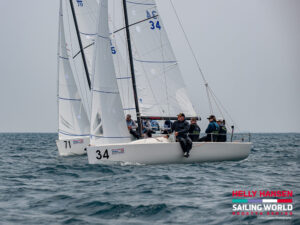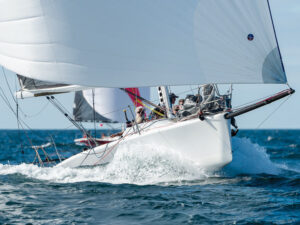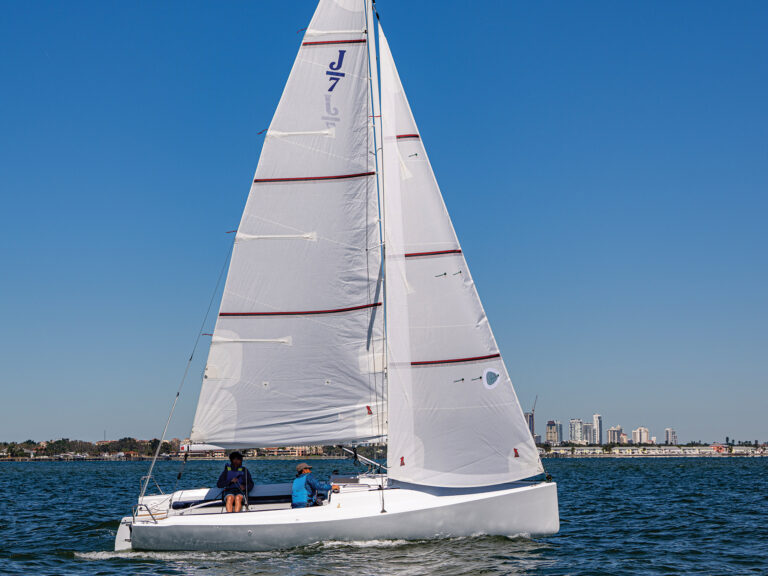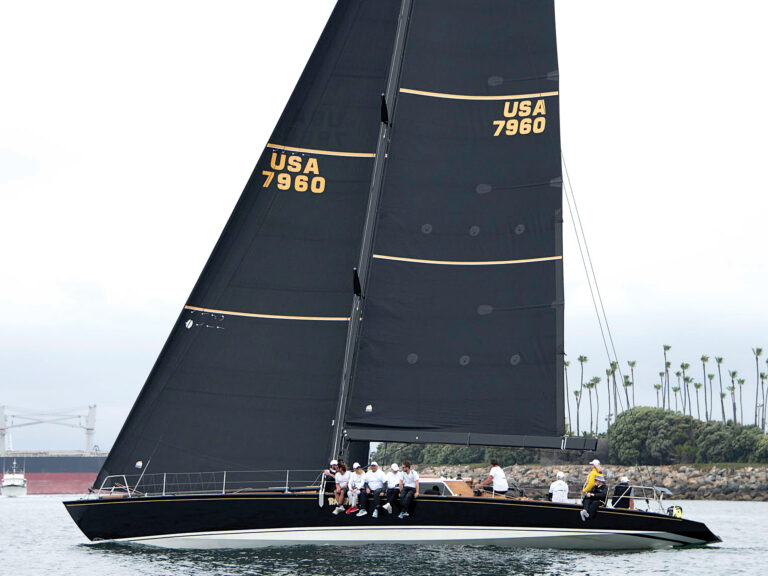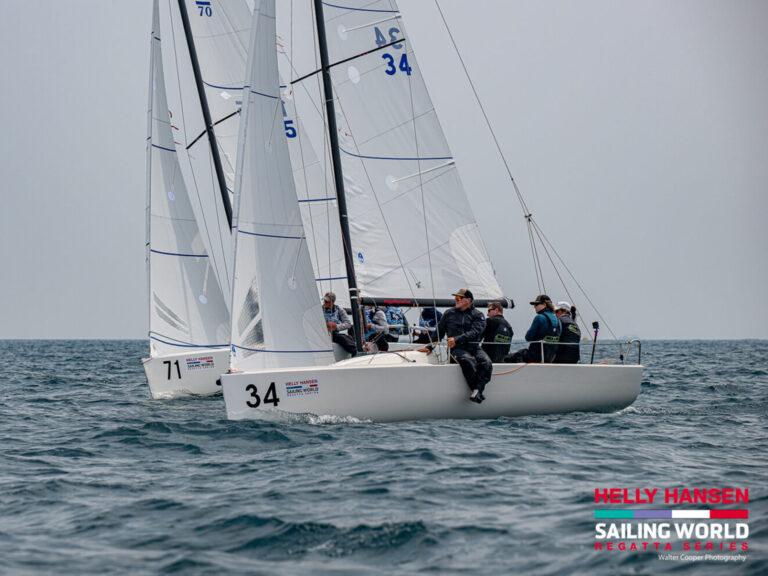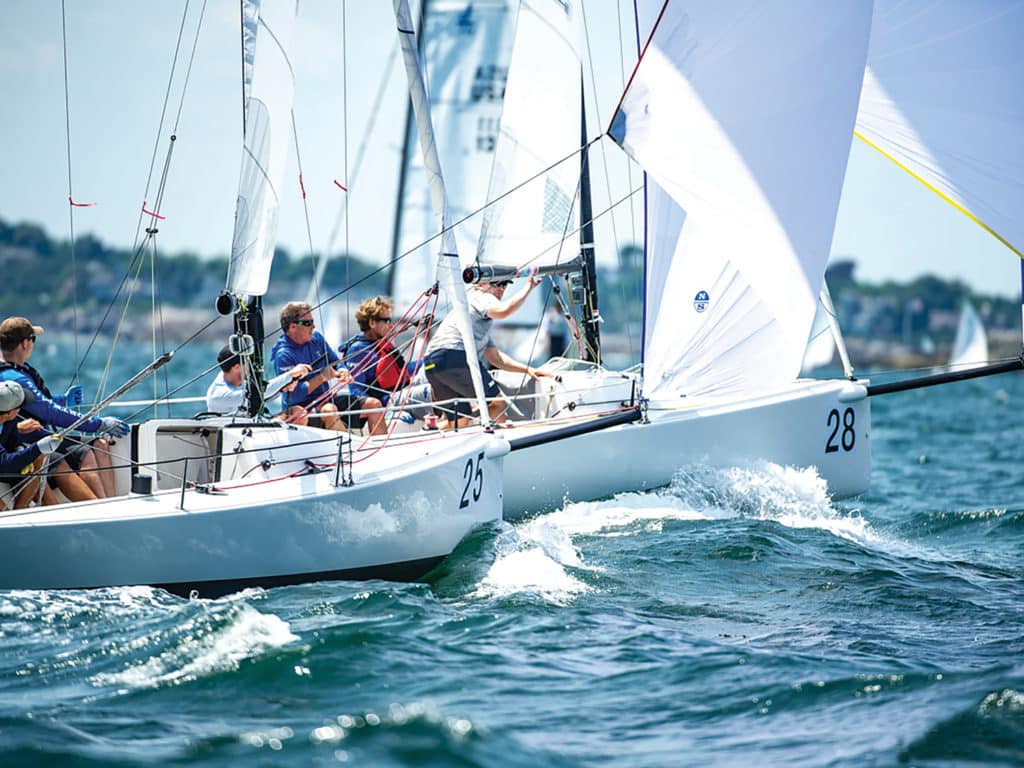
Roller-furling jibs, once viewed as a convenience for cruising boats, have become a real game-changer in the sportboat world. For example, in the prestart, when you want to control your speed and kill some time, furl the jib. Feeling late and need to get closer to the line? Deploy the jib. Downwind, when a jib is not useful, it’s much better to furl than to put the weight of a bowman on the foredeck to drop the jib, not to mention the resulting beating the sail takes as it is shoved into a pile on the foredeck, instead of being neatly rolled around the headstay. Furling also makes transitioning between the soaking mode and the planing mode a much simpler affair. The roller-furling jib gives you the unique ability to do all that and more. The key is to know when to furl and when to deploy.
For a Fine-Tuned Approach
The basic rule is, in light wind leave the jib out, because you need speed; in medium and heavy air, furl the jib until the final acceleration. In light air it’s easy to get too slow and end up late. Maneuvering and accelerating also are tough without the jib, especially when it’s light. In medium or heavy winds, it’s easy to generate enough speed until the final acceleration with the main only. Only unfurl the jib early if you end up behind the game in positioning or need to perform a maneuver, such as a double-tack when someone steals your hole. Let’s take a look at some common prestart situations.
Let’s say you’re doing a timed loop in medium breeze and your goal is to be at “x marks the spot” at one minute. That spot is on the layline for where you want to start, for example one-third down the line from the committee boat. Having done a few practice starts, you know you want to tack around that spot about 197 feet from the line at one minute. But if you realize you are running late to get to that spot and you’re furled, deploy the jib and beeline it to that spot.
Or, perhaps your initial timing was wrong, other boats forced you to sail extra distance, or your last head-to-wind took longer than expected. Time to deploy and get where you need to be. Once you’ve made up the lost time, furl, do your tack, and now you’re where you should have been in the first place.
Here’s another common situation. The committee boat is favored so much that there’s a general recall, and the committee calls everyone back and announces they are going to move the pin up. So the whole fleet sails to the pin like a swarm of locusts to get their pings. It’s a chaotic battle, with everyone taking their turns and trying not to hit each other. After all this, you check the bias of the line and realize the boat’s still favored—they didn’t move the pin enough to windward. Then the sequence begins. It’s a 50-boat line, and you’re thinking, “Oh no! We’ve got to get back to the committee boat end, and it’s a three-minute sail.” Deploy the jib.
In my usual starting sequence, I do a timed-loop with the jib furled; if everything’s fine, I unfurl at about 20 seconds. With any instruments that allow you to see distance to the line, the goal is to accelerate and be at full speed within 6 feet of the line at the gun. The instruments help you understand the ratio of feet to seconds with and without the jib, which helps you know when to deploy the jib for your final acceleration.
### Pro Tip #1
J/70 World Champ Jud Smith has a saying about furling: “Never have a bad furl, it’s like kicking your dog; you just don’t do it!” Indeed, it’s easy to put big creases in the jib when furling, which reduces the sail’s useful life. To avoid that, make sure the sheets are slack. Then, tighten the jib halyard just before furling to increase the luff tension on the sail. On the J/70, we accomplish this by bow-stringing the jib halyard where it exits the mast.
The short version is, if you’re feeling late, deploy the jib to make up the time, and if you’re feeling early, stay slow and wait to deploy. The ability to furl or deploy the jib, with the guidance of a GPS, makes it easier to get that time and distance right. The challenge is that, because the whole fleet has the same tools, everyone is that much closer to the line at the gun.
As an example, on a J/70, with the jib furled in medium wind, it’s about 1-to-1. So if you tack at 60 seconds to the gun and 200 feet from the line, and you cruise with the main only, that ratio will be going down another 3 feet per second. If you did nothing, you’d start at 0 seconds, right on the line, but with the jib furled. Of course you’d never do that. Instead, tack at 260 feet and 60 seconds, giving you 65 extra feet to work with. Now you’re marching toward the line, and the feet and seconds are still reducing at about 1-to-1. You’re watching them both go down as you’re managing your east-to-west spacing, making sure you have a hole to leeward, and dealing with threats from other boats. You know from practice runs on the start that your speed doubles when you deploy. Somewhere around 10 to 15 seconds, deploy the jib and start going 6 feet per second instead of 3 feet per second. If you get it right, you nail the start—3 to 6 feet back from the line, at full speed and close-hauled.
Some people make spreadsheets with various time-and-distance ratios for given wind strengths to help figure out how far away to set up and when to deploy.
I’ve had little success with those. The problem is that a number of other factors, such as current, sea state, bad air and line bias affect your closing speed to the line. If the pin is favored, it takes longer to get to the line from a given distance. And if the boat is favored, it takes much less time for that same distance. The more line bias, the more it affects your closing speed. Add other boats and current into the mix, and it gets complicated. I’ve found the best way to get it right is to do some practice starts, keep your eyes open to changing conditions and figure it out race by race.
If I am unsure whether the jib should be furled, I often look at other people’s setups and VMG, then decide. I only need to know whether I’m gaining or losing. If I’m losing, I match the other boat’s sail configuration.
For Downwind Situations
If you’re in displacement mode and sailing deep, furl. Whenever the apparent wind is forward, jib out. Another basic rule of thumb is that the spinnaker is always the first priority. If you’re having trouble flying it, furl the jib. Think of the jib as a bonus when you can use it; you don’t need it all the time.
On a J/70, the jib is mostly furled unless it’s windy. The exceptions are if you’ve overstood, or if you have to head up to defend, such as when someone behind is reaching up to roll you. Then deploy. With the wind forward, it’s faster with it out, as the jib is not blocking the spinnaker. When the jib is furled or deployed depends on the type of boat. For instance, on the Melges 20 we keep the jib out much of the time. Only in really light air, when the sheet tension on the jib goes away, do we furl.
### Pro Tip #2
It’s just before the start, and you need to go head-to-wind to do a final wind check. But with the jib furled, the main doesn’t really luff in the center of the boat that well. Solution? Unfurl just 2 to 3 feet of the jib and use that as your guide. Once finished, use it to assist in bearing off by pulling it one way or the other to backwind and help the turn. Then you can easily furl that small section of sail without having to fully bear away.
If I am unsure whether the jib should be furled, I often look at other people’s setups and VMG, then decide. I only need to know whether I’m gaining or losing. If I’m losing, I match the other boat’s sail configuration.
The jury is still out about whether to furl when jibing. If it’s breezy, and the jib is out, some crews furl, jibe then unfurl because the jib can mess up the spinnaker a bit when it’s filling on the new tack. For those who leave it out in heavy air, a standard jibe includes letting the jib luff on the exit of the jibe to help the kite fill. Once that happens, trim and you’re off and running again.
Of course, blow-through jibes require the jib to stay deployed, because it acts as a wall that the spinnaker slides around while the jib is backwinding. For those jibes, the jib is left-cleated and the skipper turns quickly, backwinding the jib and kite against it, letting the kite slide around the forestay and onto the new side.
Once the kite is around, the jib trimmer uncleats the old jib sheet and trims the new sheet once the kite is full.
RELATED: 5 Tips for Better Asymmetric Speed
At leeward marks you either need to deploy the jib, then drop the chute or drop the chute, then deploy the jib. I’ve seen people try to drop the chute while unfurling the jib at the same time, and it can get ugly. Because you have a spinning furler near a loose spinnaker halyard, it’s easy for the halyard to wrap around the jib and forestay—then it’s probably race over.
If you watch a video of a 50-boat fleet in the J/70s, 48 of them will deploy the jib, drop the kite, then round the mark. Two might drop kite, start heading up then deploy the jib. There are arguments for each. I like to get the jib out, then douse, just in case there is someone reaching in to the leeward mark before you head up. Two-sail reaching is always faster than one!


